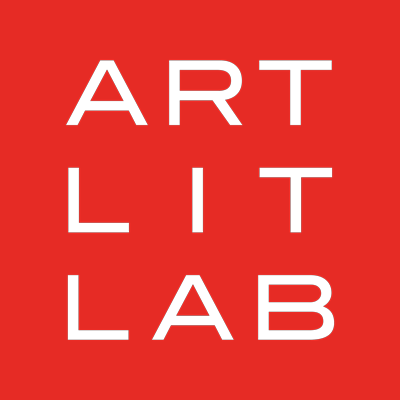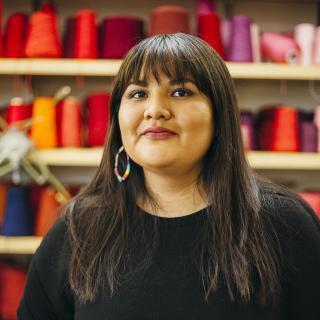ALL Review: How did you get your start as an artist? Do you have an origin story?
Dakota Mace: My family is pretty art centric. All of my family does silversmithing, so I grew up watching my grandpa do silversmithing, my aunts, my uncles. In my family, art is connected to everything, so it was something I’d always done, but I didn’t start doing photography until I was in high school, about fifteen or sixteen. From there, I decided I wanted to go to art school in Santa Fe. That was when I learned to work with different mediums like photography and printmaking. When I moved to Madison for grad school, I got really into working with fibers because of the history connected to it, for my family at least.
AR: So, you said your family does it, but do you also do silversmithing?
DM: No—it’s kind of funny—when I was really small, I had an allergy to silver. So, I just decided to work with another type of silver, which is photography! To this day I still have a slight sensitivity to silver, but eventually I do want to learn to do silversmithing. I’ve worked in collaboration with my grandfather on a couple of my pieces. He does his silverwork, and then I combine it with my textiles or photography.
AR: What got you into photography?
DM: Initially, I was just really interested in working in a dark room as a kid. I grew up in Albuquerque, and the arts programs in our schools, especially our public schools, were essentially nonexistent. I took photography with this small center—which is still there—the Harwood Art Center. They worked with inner city kids, bringing the arts to them. That was the first place I got to interact with film photography, and I just fell in love with the process.
AR: What were your early influences? What’s influencing you lately?
DM: My family has always been a big influence for my work. Like I said, I work with my grandfather, and a big part of a lot of my work is carrying on stories and traditions, as well as conveying the importance of design and relationship to land. Within Diné (Navajo) culture, everything centers on this idea of land, and its importance to us, and creating this sense of balance. That’s been my biggest inspiration, and it’s always been part of my work. What I hope to do with this current body of work that I’m slowly designing and creating is to continue working not only with my family but also the community where my family comes from. It’s a small town in the eastern part of Navajo nation. There’s something really beautiful about being able to collaborate with community members, and keep that sense of community alive, and also to highlight artists that are huge inspirations to me. I think the hardest struggle of working within fine art is that people assume that only things like paintings and photography are considered fine work, but for me it was always about watching my elders, watching my grandfather create things. I considered them masters of their craft. I just want to be able to support the community.
AR: I’m wondering about the concept of “home” and how it relates to your work. Where is home for you? How does your home shape your work?
DM: I grew up in Albuquerque, New Mexico, but my family is from Torreon, New Mexico which is part of the eastern agency of Navajo nation. Something that’s always been a big part of me, especially since moving up north to Madison about seven years ago, was this disconnect from home and longing for it, so a lot of my very early work in grad school focused on wanting to be able to go back home, to be connected to home. For me, my artwork is still that extension—even if I can’t physically be in New Mexico, I can create work that reminds me of my home, so each piece is a little bit of home to me. Essentially, I create for my community and for Navajo people because there’s something really special about our stories and this beautiful understanding we have of the work that we create. That’s something I try to instill within my work. Our art is finally being acknowledged, and it’s great to be able to see Navajo work that isn’t associated with pan-Indianism and people’s heavy, weird assumptions of what native art looks like.
AR: What does your artistic practice look like on a daily basis?
DM: It varies. I usually don’t draw or sketch things out. A lot of my work comes from mulling over thoughts, ideas, designs, things that may remind me of certain stories that my grandfather or my mom would tell me. When I was smaller, I loved listening to my family speak in Navajo. That’s something I still love to this day, just hearing the way our language sounds. A lot of things get lost in translation when you try to translate it into English. There’s something really special about being able to utilize language in a different way, a kind of visual translation. That’s how I tend to build things. I also tend to create things just because I just felt compelled at that moment to start doing something, so often a lot of my work is building upon that. It reminds me of the practice of Diné weavers because there was no true mapping of their design. It just came to them as they were creating the work, so I try to follow a very similar practice. It’s very hard to tell people what I envision my work to look like because it changes every couple of days or every month.
AR: Do you have a favorite piece that you’ve made, or one that you’re most proud of?
DM: I think all of them end up being my favorite! But one of my more important pieces is titled Dahodiyinii or Sacred Places. That piece is really special because it’s part of a larger project about the long walk that my ancestors took to Bosque Redondo in New Mexico. It was at the internment at Bosque Redondo that so many of our stories were lost. Often Diné people were only categorized by a number, so there was no sense of identity, there was no sense of individuality. And I think creating that piece was about—almost an extension for myself—giving my ancestors and the land a chance to take a photograph. Each print is a cyanotype that I let the land and the natural environment create—whether that’s the wind or the water – and added on top of it, really abstracting it further by dying it in cochineal. There’s something really special about cochineal because there’s so much history connected to the color red for Diné people, and also it was a big thing that was traded in many communities and by many Diné women. It’s so special to be able to connect to materials in that way. Right now, there are, I want to say, over 400 of those cyanotypes that I’ve created. Eventually I want to make over 2,000, each being a representation of the (inaccurate) number of Diné lives that were lost during that walk and also at the camp.
AR: Do you have a favorite medium, or one that you’re really enjoying working with right now?
DM: At the moment, it’s beading. I’ve been doing a lot of beadwork. That’s something I really enjoy doing because it’s a very quiet practice, just you and the beads. What’s really nice is that I’m able to transport it home if I want to do it while I’m watching TV or hanging out with my cat or my husband. I think there’s something really special about the history of beads too. At least for Indigenous people, it’s such a new medium in comparison to many of the traditional things that we use. There’s something special about the history of the trade and the movement of these materials that I find really interesting and tend to like to bring up within my work. It’s a long process, but I enjoy doing it.
AR: What is bringing you joy right now? Where do you find hope?
DM: I think the most exciting thing right now is that I am an MFA mentor for the Institute of American Indian Arts. It’s the college where I got my bachelor’s. Something really special is that this MFA program is completely new, and it’s a low-residency program. I’ve enjoyed working with the grad students because it’s a chance to focus on highlighting indigenous pedagogy and histories without having the difficult structure of traditional MFA programs. It’s a unique combination of MFA students with the perspective of indigenous histories and people. It's so exciting because there’s such interesting conversations not only with my colleagues but also with the students about what it means to be an indigenous person, what it means to be a person of color. It’s allowing more space for our voices to exist in places that are very structured and oftentimes have a deeply rooted colonial history.
Featured work: Náhookǫs Bikǫʼ I
Chemigram, Glass Beads, & Abalone Shell
11” x 14” Each (Print)
2022


